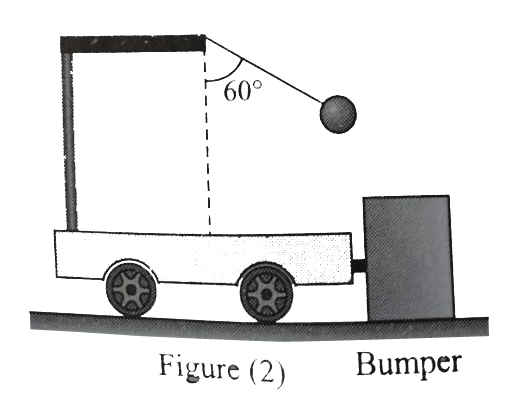Three carts move on a frictionless track with masses and velocities as shown. The carts collide and stick together after successive collisions. Find the total magnitude of the impulse experienced by

The correct Answer is:C
Let the final velocity of the combined system be , then applying conservation of linear momentum we get
Impulse experiencedby change in momentum of
Topper's Solved these Questions
- MISCELLANEOUS VOLUME 2BOOK - CENGAGE PHYSICS ENGLISHCHAPTER - MISCELLANEOUS VOLUME 2EXERCISE - MCQ_TYPE
20 Videos
- MISCELLANEOUS VOLUME 2BOOK - CENGAGE PHYSICS ENGLISHCHAPTER - MISCELLANEOUS VOLUME 2EXERCISE - LC_TYPE
34 Videos
- MISCELLANEOUS KINEMATICSBOOK - CENGAGE PHYSICS ENGLISHCHAPTER - MISCELLANEOUS KINEMATICSEXERCISE - Interger type
3 Videos
- NEWTON'S LAWS OF MOTION 1BOOK - CENGAGE PHYSICS ENGLISHCHAPTER - NEWTON'S LAWS OF MOTION 1EXERCISE - Integer
5 Videos
Similar Questions
Three carts move on a frictionless track with masses and velocities as shown. The carts collide and stick together after successive collisions. Find the total magnitude of the impulse experience by A.
m1=3kg,m2=1kg,m3=2kg
v1=1m/s,v2=1m/s,v3=2m/s→+ve

View SolutionTwo particles are seen to collide and move jointly together after the collision . During such a collision, for the total system,
View SolutionA body of mass 3 kg moving with a velocity (2ˆi+3ˆj+3ˆk) m/s collides with another body of mass 4 kg moving with a velocity (3ˆi+2ˆj−3ˆk) m/s. The two bodies stick together after collision. The velocity of the composite body is
View SolutionA sphere of mass m slides with velocity v on as frictionless surface towards a smooth inclined wall as shown in figure. If the collision with the wall is perfectly elastic find a. the impulse imparted by the wall on the sphere b the impulse imparted by the floor on the sphere.

View SolutionTwo masses of 0.25 kg each moves toward each other with speed 3 ms−1 collide and stick together. Find the final velocity
View Solution
A cart of mass 3 kg is pulled by a 5 kg object as shown in figure. Length of cart is 40 cm moves on frictionless table. There is a small brick of mass 2 kg on the cart which falls at 0.8 sec. after the start of motion. if the coefficient of friction between cart and brick is x10. then value of x is :(g=10m/s2)
View SolutionTwo balls of masses 2kg and 4kg are moved towards each other with velocities 4m/s and 2m/s, respectively, on a frictionless surface. After colliding, the 2kg ball returns back with velocity 2m/s. then find
a. velocity of the 4kg after collision
b. coefficient of restitution e,
c. impulse of deformation JD
d. maximum potential energy of deformation,
e. impulse of reformation JR
View Solution

A ball is suspended from the top of a cart by a string of length 1.0m. The cart and the ball are initially moving to the right at constant speed V, as shown in figure I. The cart comes to rest after colliding and sticking to a fixed bumper, as in figure II. The suspended ball swings through a maximum angle 60∘. The initial speed V is (takeg=10(m)/(s^2))
View SolutionA ball is suspended from the top of a cart by a light string of length 1.0 m. The cart and the ball are initially moving to the right at constant speed V, as shown in figure I. The cart comes to rest after colliding and sticking to a fixed bumper, as in figure II. The suspended ball swings through a maximum angle 60°. The initial speed V is (take g=10m/s2) (neglect friction)

View SolutionAn object A of mass m with initial velocity u collides with a statinary object B after elestic collision A moves with u4 calculate mass of B.
View Solution
